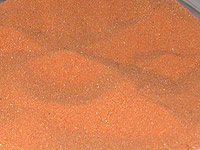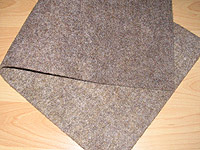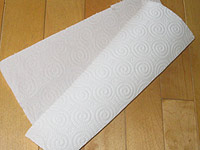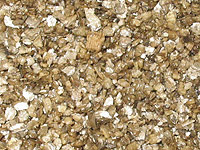In
his natural habitat, the leopard gecko lives in rocky dry lands and not
in sandy deserts. The habitat is composed of rocks, grass tufts and
sand. In my opinion, he should not be kept in sand only habitat in
captivity.
The
substrate is there to collect the excrements and to provide a steady
walking medium for the gecko to move around. Speaking of excrements,
the leopard gecko is known to poop always in the same spot. Even if
there are many individuals in the same tank, they will end up all in
the same place. So, the cleaning task is very easy.
Sand
 This
is a topic that makes and will make reptiles breeders talk a lot about.
In Pet Stores, you'll find many different types of sand in a wide
variety of colours and textures. The problem with the sand is that the
gecko eats of it when licking the substrate and also when catching
preys walking on it. If the gecko eats too much of it, it can compact
and block his digestive track and then kill him. Some will say
that they been using sand with their geckos for a long time without
any problems. Even me, I housed my first pair on sand and they did
very well. It's up to you to make the choice.
This
is a topic that makes and will make reptiles breeders talk a lot about.
In Pet Stores, you'll find many different types of sand in a wide
variety of colours and textures. The problem with the sand is that the
gecko eats of it when licking the substrate and also when catching
preys walking on it. If the gecko eats too much of it, it can compact
and block his digestive track and then kill him. Some will say
that they been using sand with their geckos for a long time without
any problems. Even me, I housed my first pair on sand and they did
very well. It's up to you to make the choice.
There
is one thing sure, it's that young gecko under one year old should not
be kept on this substrate as their digestive system is too small and
the risk of compaction is higher.
Repticage
carpet
 Surly
the best compromise between esthetic and security. Those are carpets
made in a variety of colours precutted to the standard aquariums sizes.
To make your cleaning time easier, buy two of them so that you can
change the carpet and replace it with the other one while cleaning it.
I noticed that young gecko sometimes had little problems walking
around on these because their claws get caught in it, but not to the
point of being a real problem.
Surly
the best compromise between esthetic and security. Those are carpets
made in a variety of colours precutted to the standard aquariums sizes.
To make your cleaning time easier, buy two of them so that you can
change the carpet and replace it with the other one while cleaning it.
I noticed that young gecko sometimes had little problems walking
around on these because their claws get caught in it, but not to the
point of being a real problem.
Paper
towel
 This
may seem a little odd but this is the substrate use the more often by
gecko breeders. It is safe, cheap and it makes the job but it's not so
esthetical. Once it is dirty, all you have to do is get rid of it and
place a new one. The geckos are totally safe with this substrate
and won't eat of it. You can place some little rocks around it to
prevent the crickets to go under it.
This
may seem a little odd but this is the substrate use the more often by
gecko breeders. It is safe, cheap and it makes the job but it's not so
esthetical. Once it is dirty, all you have to do is get rid of it and
place a new one. The geckos are totally safe with this substrate
and won't eat of it. You can place some little rocks around it to
prevent the crickets to go under it.
Rocks
You
can build a realistic rocky habitat with some slate rocks. You can
also build the hiding spots with those rocks. Just pay attention to
the way you place them together so that it don't fall apart on
your gecko. You can glue them together with melting glue. One of the disadvantages is that crickets can hide
more easily in this kind of habitat. Try pouring some sand in the
small holes between the rocks but be aware that crickets can dig small
holes in sand to hide. The other thing is that cleaning can be a
little more complicated as the substrate is part of the habitat.
You'll have to clean the habitat directly in the tank.
Ceramic
tiles
At
your hardware store, you can find some really nice ceramic tiles of
the colour of your choice. You'll only have to remove the dirty ones,
clean them under hot water and place them back in.
Vermiculite
 This
is a material used in many domains. Like in horticulture, it's used to
keep the moisture, in construction it's used to make the concrete
lighter. Usually with reptiles, vermiculite is used to create laying
condition, for incubating eggs and to create a humid environment for
the shedding box. I do use it dry as a substrate for all my geckos. I
noticed that young gecko would eat some of the substrate found in
their hatching box and that this didn't seems to make them sick as I
found some in their excrement. To be certain that they don't choke
with big vermiculite parts, I use a strainer to ground it in small particles. The vermiculite has the characteristic to be very soft and easy to
crush. You can even crush in with your fingers. It is spongy when
compress. This may be why it seems to pass so easily in the digestive
track.
This
is a material used in many domains. Like in horticulture, it's used to
keep the moisture, in construction it's used to make the concrete
lighter. Usually with reptiles, vermiculite is used to create laying
condition, for incubating eggs and to create a humid environment for
the shedding box. I do use it dry as a substrate for all my geckos. I
noticed that young gecko would eat some of the substrate found in
their hatching box and that this didn't seems to make them sick as I
found some in their excrement. To be certain that they don't choke
with big vermiculite parts, I use a strainer to ground it in small particles. The vermiculite has the characteristic to be very soft and easy to
crush. You can even crush in with your fingers. It is spongy when
compress. This may be why it seems to pass so easily in the digestive
track.
Note:
This is a personal observation and it never been proven
good or wrong by any reptile specialist.

